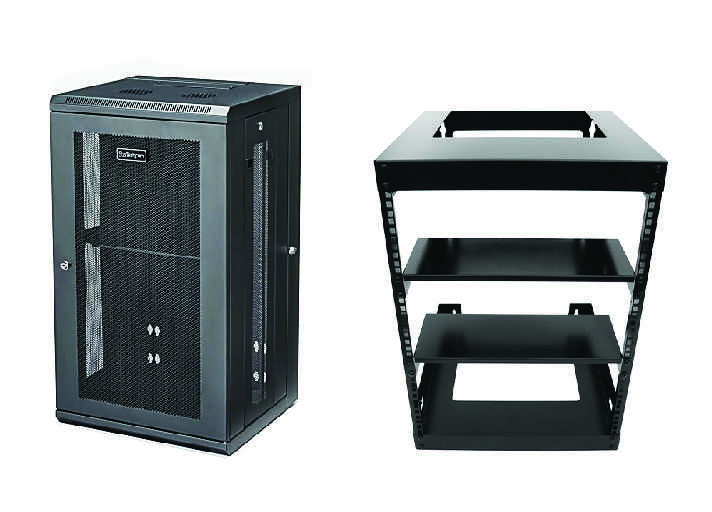An IT system stands as the “heart” of any business. It consists of multiple components (their number can reach several hundred). Specialized server furniture is used to house and store this equipment.
The modern market offers a wide catalog of models for any need, size, and type of installation. According to the type of body, furniture falls into enclosed cabinets and open-frame racks. The difference between both categories is that the first one has solid enclosures with side panels, while the latter one has only two or four vertical posts without doors and walls.
Open-Frame Racks: Essence, Types, Benefits
An open-frame server rack is a metal body that consists of 2 or 4 vertical uprights with tech slots. No doors, tops, or walls are provided by its construction. The model catalog ranges from small to large products. Both wall-mount and floor-standing furniture pieces are produced.
Advantages of Open Bodies
An open-frame server rack is preferable due to the next pros:
- Price. Such products are cheaper and more affordable than enclosures since fewer materials are used for their manufacturing.
- Easy maintenance and access. No doors, panels, or tops allow for easier access to devices. The staff can approach racks from all sides and maintain hardware without disassembling an entire system.
- Airflow and cooling. The absence of panels simplifies cooling strategies since the airflow can pass through devices and cool them. Walls do not impede penetration and effectively exchange heat.
- Easy building and transportation. Rack disassembly and installation take just a few minutes. When transported, racks are compact and do not take much place.
- Easy cable management. Technicians can decide how and where to route cords. The staff uses various accessories to organize cables.
However, due to easy accessibility racks do not provide enough security for devices. Thus, intruders can damage systems or technicians can unintentionally hit equipment. Moreover, the lack of panels leads to dust settlement and increased pollution, which results in overheating.
Enclosed Cabinets: Core, Benefits, and Kinds
When selecting the right server rack, Choosing the right server rack size for your equipment is crucial to ensuring optimal performance. Properly sizing your rack maximizes space utilization, improves airflow, and simplifies maintenance. An enclosed server cabinet, typically made of a solid metal frame with perforated side panels and doors, provides a secure and well-ventilated environment for your equipment. These cabinets offer ample space, with sizes ranging from 36U to 48U, allowing for efficient organization and easy access to various components. Ensuring the correct size not only enhances performance but also keeps your setup organized and well-maintained.
Perks of Solid Enclosures
The following advantages determine the popularity of this category:
- Protection. Increased security and reliable protection from all sorts of external impacts are the main benefits of enclosed models. Placing hardware in solid metal boxes prevents equipment from accidental and intentional damage, unauthorized access, and pollution. This feature allows for installing enclosures in public and open spaces.
- Airflow control. Metal constructions have perforation and all the needed slots for cooling device mounting. Thus, it is possible to create a stable inside environment with optimal climatic conditions and maintain the required temperature and humidity. Sensors help control indicators and eliminate hazards promptly.
- Hiding cables. Enclosures are equipped with holes for routing cords. Moreover, technicians can hide wires inside enclosures and prevent occidental rapture.
Yet, solid cabinets lag in terms of price, moving, and restricted access. Since more metal is required for cabinet production, the cost of furniture is higher. Moving is hardened due to weight and shape; large cabinets are bulky and less portable. Finally, side panels impede maintenance and hardware access.
Open Racks VS Enclosed Cabinets: Comparison
How to decide what class of products you need? Let’s compare both categories and highlight the main features of each solution. Comparison is made according to the following parameters:
- cooling;
- security;
- portability;
- ease of access;
- the place of mounting.
An open frame network rack has an advanced point in terms of cooling technologies. They do not need cooling devices to force the air to circulate, while enclosed furniture requires fan mounting to force the air to move and reduce temperature.
As for protection, here, an opposite tendency is observed. Enclosures reliably protect equipment, while open bodies cannot prevent hardware from damage. However, note that if you add removable side panels, an enclosed server rack also improves its security characteristics.
Open constructions are characterized by better flexibility in comparison with bulky solid boxes. When relocating, open-frame furniture is easier disassembled and transport.
The absence of walls and doors provides easier access to devices, which simplifies maintenance. Enclosures have poor characteristics in terms of accessibility.
As for location, each category of furniture has its targeted place. Open models are used in closed server rooms and data centers. Solid enclosures are ideal for public places (banks, hospitals, offices, stores, and other establishments) and open spaces.
The sizes of both models range greatly from compact products to large spacious ones. Both small wall-mount and big floor products are found on the market. Both categories of high-quality products are in great demand on the market. Each class of furniture is suitable for particular premises, types of systems, and demands. Thus, when selecting a suitable model, system administrators should take into account how many components their systems have, where the furniture will be placed, what cooling strategies are preferable, and how will have access to hardware.











